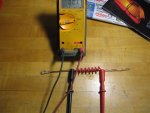DontPanic42
Adventurer
This sounds like an interesting project. As you have probably already noticed, the voltage from the panel doesn't give you a whole lot of information, you really need to know the current it is providing. Under almost any daylight illumination, you get almost the full voltage output from the panel, but current (and therefore power) will track insolation very well. The easiest way to measure the current is with a shunt resistor (as you suggest), however your 30.00 maxDC +/- 50mDCV data logger won't give you the resolution you need to measure the voltage drop across the shunt. For instance, if you were to use a 0.01 ohm shunt, 4amps would give you a signal of 40mV, or less than one bit on your system. A larger resistance shunt will end up dissipating a lot of heat.
You do something crafty with a pair of shunts to split the current flow in a known ratio, say 200:1 and measure the current on the higher resistance shunt directly with your current sensor. For example you could use a 0.001 ohm shunt and a 0.2 ohm resistor in parallel and measure the current through the 0.2 ohm resistor and multiply it by 200 to get the total current.
Thanks for the reply. I thought I would have to play some games to be able to use the test equipment I have. Please bear with me if I ask some pretty basic questions. My last EE class in DC circuit theory was in '63 so I am a bit out of date. In your example, you mention a 0.001 ohm shunt. The shunts I have and have seen are marked as an example, 100:10. Max of 100 amps in with a max of 10 mvdc out. I assume that a simple ohms law calculation determines the resistance. Also, they are bar style shunts with the input lugs at the extreme ends and the output on the top in the center. Where should the resistor be located? Do I just chose a resistor that gives me a large enough ratio that I won't fry my equipment or do you have a rule of thumb calculation?
Do you know of any articles describing use of DC shunts made simple for retired Metallurgists turned cooks? Pictures or drawings would help.
Told you I had some real basic questions.
Thanks again for the comments.
Last edited:

